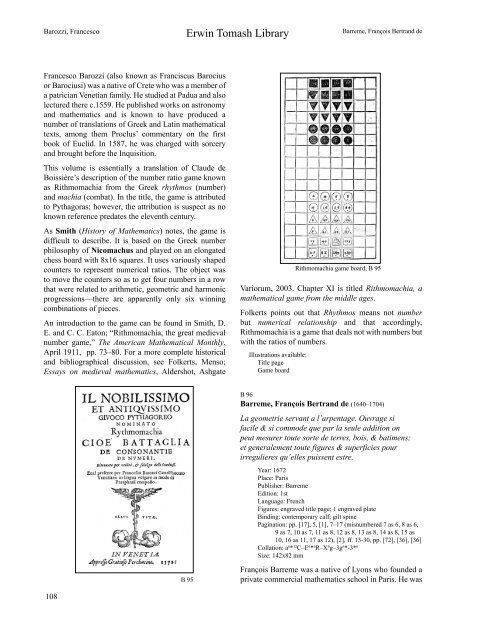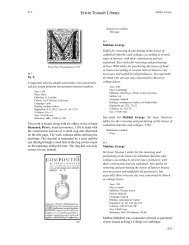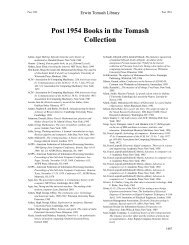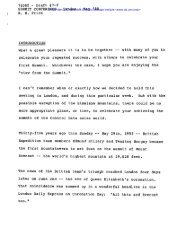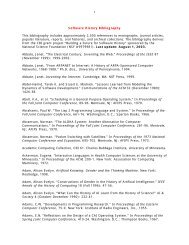B chapter.indd - Charles Babbage Institute - University of Minnesota
B chapter.indd - Charles Babbage Institute - University of Minnesota
B chapter.indd - Charles Babbage Institute - University of Minnesota
You also want an ePaper? Increase the reach of your titles
YUMPU automatically turns print PDFs into web optimized ePapers that Google loves.
Francesco Barozzi (also known as Franciscus Barocius<br />
or Barociusi) was a native <strong>of</strong> Crete who was a member <strong>of</strong><br />
a patrician Venetian family. He studied at Padua and also<br />
lectured there c.1559. He published works on astronomy<br />
and mathematics and is known to have produced a<br />
number <strong>of</strong> translations <strong>of</strong> Greek and Latin mathematical<br />
texts, among them Proclus’ commentary on the first<br />
book <strong>of</strong> Euclid. In 1587, he was charged with sorcery<br />
and brought before the Inquisition.<br />
This volume is essentially a translation <strong>of</strong> Claude de<br />
Boissière’s description <strong>of</strong> the number ratio game known<br />
as Rithmomachia from the Greek rhythmos (number)<br />
and machia (combat). In the title, the game is attributed<br />
to Pythagoras; however, the attribution is suspect as no<br />
known reference predates the eleventh century.<br />
As Smith (History <strong>of</strong> Mathematics) notes, the game is<br />
difficult to describe. It is based on the Greek number<br />
philosophy <strong>of</strong> Nicomachus and played on an elongated<br />
chess board with 8x16 squares. It uses variously shaped<br />
counters to represent numerical ratios. The object was<br />
to move the counters so as to get four numbers in a row<br />
that were related to arithmetic, geometric and harmonic<br />
progressions—there are apparently only six winning<br />
combinations <strong>of</strong> pieces.<br />
An introduction to the game can be found in Smith, D.<br />
E. and C. C. Eaton; “Rithmomachia, the great medieval<br />
number game,” The American Mathematical Monthly,<br />
April 1911, pp. 73–80. For a more complete historical<br />
and bibliographical discussion, see Folkerts, Menso;<br />
Essays on medieval mathematics, Aldershot, Ashgate<br />
108<br />
Erwin Tomash Library<br />
Barozzi, Francesco Barreme, François Bertrand de<br />
B 95<br />
Variorum, 2003. Chapter XI is titled Rithmomachia, a<br />
mathematical game from the middle ages.<br />
Folkerts points out that Rhythmos means not number<br />
but numerical relationship and that accordingly,<br />
Rithmomachia is a game that deals not with numbers but<br />
with the ratios <strong>of</strong> numbers.<br />
Illustrations available:<br />
Title page<br />
Game board<br />
Rithmomachia game board, B 95<br />
B 96<br />
Barreme, François Bertrand de (1640–1704)<br />
La geometrie servant a l’arpentage. Ouvrage si<br />
facile & si commode que par la seule addition on<br />
peut mesurer toute sorte de terres, bois, & batimens;<br />
et generalement toute figures & superficies pour<br />
irregulieres qu’elles puissent estre.<br />
Year: 1672<br />
Place: Paris<br />
Publisher: Barreme<br />
Edition: 1st<br />
Language: French<br />
Figures: engraved title page; 1 engraved plate<br />
Binding: contemporary calf; gilt spine<br />
Pagination: pp. [17], 5, [1], 7–17 (misnumbered 7 as 6, 8 as 6,<br />
9 as 7, 10 as 7, 11 as 8, 12 as 8, 13 as 8, 14 as 8, 15 as<br />
10, 16 as 11, 17 as 12), [2], ff. 13-30, pp. [72], [36], [36]<br />
Collation: a 6 * 12 C–E 6 * 6 R–X 6 g–3g 6 *-3* 6<br />
Size: 142x82 mm<br />
François Barreme was a native <strong>of</strong> Lyons who founded a<br />
private commercial mathematics school in Paris. He was


